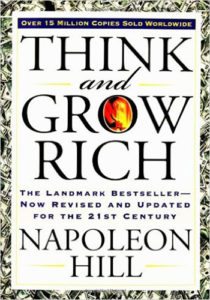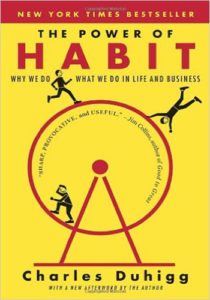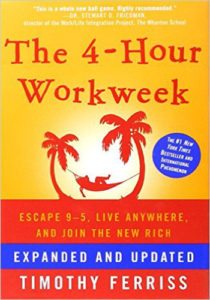Success Advice
5 Inspirational Books That Will Boost Your Growth

Regardless of who you are and what you do, there will be periods both in your personal and professional life where you will feel less than motivated and inspired. It happens to everybody at some point. The trouble with such dry spells is that not only do we lack enthusiasm, but we begin to question ourselves. Instead of believing in our abilities and skills, we come to doubt them, despite all the success we have had so far.
It’s a slippery slope, and in order to avoid getting stuck, you need to do everything in your power to get motivated again, instead of just waiting for it to happen. One of the best ways to get back on track is to rely on the power of the written word, and read some motivational books that will give you a much-needed boost.
Here is a list of 5 of the best ones to read:
1. Think and Grow Rich by Napoleon Hill
 Written back in the 1930s, this book is still one of the best ones ever published when it comes to self-improvement and personal growth. Even if you aren’t impressed by the fact that it was sold over 70 million copies. Well, you should be, because although the title suggests that you will get rich by reading the book, a more important takeaway is the philosophy inside it. More specifically, it is about the positive effects of the Mastermind principle, which was established by Napoleon Hill himself.
Written back in the 1930s, this book is still one of the best ones ever published when it comes to self-improvement and personal growth. Even if you aren’t impressed by the fact that it was sold over 70 million copies. Well, you should be, because although the title suggests that you will get rich by reading the book, a more important takeaway is the philosophy inside it. More specifically, it is about the positive effects of the Mastermind principle, which was established by Napoleon Hill himself.
“Strength and growth come only through continuous effort and struggle.” – Napoleon Hill
2. You Are a Badass: How to Stop Doubting Your Greatness and Start Living an Awesome Life by Jen Sincero
 Using her experience as a success coach and a best-selling author, this book provides an entertaining alternative to all those boring and repetitive self-help books you would disregard without even considering them for a second. Although full of witty remarks, pronounced humor, and even some four-letter words thrown in for good measure, this book is actually a serious read aimed at anyone who is looking to improve their career. It does that by focusing on what’s really stopping you from realizing your full potential: yourself.
Using her experience as a success coach and a best-selling author, this book provides an entertaining alternative to all those boring and repetitive self-help books you would disregard without even considering them for a second. Although full of witty remarks, pronounced humor, and even some four-letter words thrown in for good measure, this book is actually a serious read aimed at anyone who is looking to improve their career. It does that by focusing on what’s really stopping you from realizing your full potential: yourself.
Most people have a similar mindset, where they think they will fail before they have even tried. With this book, you will learn how to stop doubting your abilities and focus on your strengths, while at the same time accepting your flaws and owning them.
3. The Power of Habit: Why We Do What We Do in Life and Business by Charles Duhigg
 We all know that bad habits can ruin a person’s life, but can good habits do the opposite and improve it? If the answer is yes, how do we go about adopting good habits and implementing them into our lives for the sake of making them better? This book answers those questions. It focuses on the science behind habits, both good and bad. Every habit has three crucial components: a cue, a routine, and a reward. This is what is known as the Habit loop.
We all know that bad habits can ruin a person’s life, but can good habits do the opposite and improve it? If the answer is yes, how do we go about adopting good habits and implementing them into our lives for the sake of making them better? This book answers those questions. It focuses on the science behind habits, both good and bad. Every habit has three crucial components: a cue, a routine, and a reward. This is what is known as the Habit loop.
It also explains the Golden Rule of habit, which focuses on replacing the routine part of the Habit loop, but keeping the cue and the reward components. As a result, positive habits are adopted. This book also focuses on helping you believe in yourself, because that’s the foundation, not only of good habits, but any kind of success you are after in your life.
4. The Power of Positive Thinking by Dr. Norman Vincent Peale
 If there is one book that is synonymous with inspiration and motivation, it is this one. It has helped more than five million people achieve their goals and improve themselves and their lives. The book focuses on providing positive reassurance for the reader, but there is so much more inside the book besides kind words. Inside the covers, you will find practical techniques that will help you turn your life around and your view of it for good. You will learn how to overcome all the blocks on your way towards success.
If there is one book that is synonymous with inspiration and motivation, it is this one. It has helped more than five million people achieve their goals and improve themselves and their lives. The book focuses on providing positive reassurance for the reader, but there is so much more inside the book besides kind words. Inside the covers, you will find practical techniques that will help you turn your life around and your view of it for good. You will learn how to overcome all the blocks on your way towards success.
This bestseller will teach you how to believe in yourself again, how to find strength and motivation, as well as how to do away with all the bad habits, including worrying too much, because that’s one of the reasons why we are not leading healthier, happier lives.
“Change your thoughts and you change your world.” – Norman Vincent Peale
5. The 4-Hour Workweek: Escape 9-5, Live Anywhere, and Join the New Rich by Timothy Ferriss
 One of the most common reasons why people lack motivation and determination is because they are tired and overworked. The same happened to the author of this book. Working 14 hours a day, pretty much every day of the week, he decided that he had just had enough. While the title of the book is not exactly accurate, Ferriss did manage to come up with a system through which he reduced his working hours by a significant margin, by checking his emails only once a day and outsourcing as many small and menial tasks to virtual assistants online.
One of the most common reasons why people lack motivation and determination is because they are tired and overworked. The same happened to the author of this book. Working 14 hours a day, pretty much every day of the week, he decided that he had just had enough. While the title of the book is not exactly accurate, Ferriss did manage to come up with a system through which he reduced his working hours by a significant margin, by checking his emails only once a day and outsourcing as many small and menial tasks to virtual assistants online.
It worked for him, and with a few adjustments, it can work for you too, which is why this book should be at the top of your reading list.
These 5 books can help you turn your life around and become a happier and more satisfied individual. Finding the strength and motivation to go through life and achieve your goals on a constant basis is not easy, but it’s completely feasible.
Did You Know
How Skilled Migrants Are Building Successful Careers After Moving Countries
Behind every successful skilled migrant career is a mix of resilience, strategy, and navigating systems built for locals.

Moving to a new country for work is exciting, but it can also be unnerving. Skilled migrants leave behind familiar systems, networks, and support to pursue better job opportunities and a better future for their families. (more…)
Life
10 Research-Backed Steps to Create Real Change This New Year
This New Year could finally be the one where you break old patterns and create real, lasting change.

Every New Year, we make plans and set goals, but often repeat old patterns. (more…)
Change Your Mindset
The Silent Skill That Makes People Respect You Instantly
What truly earns respect and why most people go about it the wrong way

Everybody craves respect but not everyone earns it. Some people believe that a title, years of experience, or a position of authority automatically entitles them to respect. (more…)
Entrepreneurs
The Essential Skills Every Entrepreneur Needs In 2026
Success in the digital age isn’t about luck. It’s about mastering the skills that separate dreamers from doers.

When I was 22 years old, I started my first side hustle as a ghostwriter. (more…)
-

 Did You Know4 weeks ago
Did You Know4 weeks agoThe Success Patterns You Inherited (And Didn’t Notice)
-

 Entrepreneurs4 weeks ago
Entrepreneurs4 weeks agoThe Essential Skills Every Entrepreneur Needs In 2026
-

 Change Your Mindset3 weeks ago
Change Your Mindset3 weeks agoHow to Turn Your Mind Into Your Greatest Asset (Instead of Your Enemy)
-

 Change Your Mindset3 weeks ago
Change Your Mindset3 weeks agoThe Silent Skill That Makes People Respect You Instantly
-

 Life2 weeks ago
Life2 weeks ago10 Research-Backed Steps to Create Real Change This New Year
-

 Tech2 weeks ago
Tech2 weeks agoWhat’s in a Name? How to Get Your Domain Right
-

 Did You Know1 week ago
Did You Know1 week agoHow Skilled Migrants Are Building Successful Careers After Moving Countries

























4 Comments